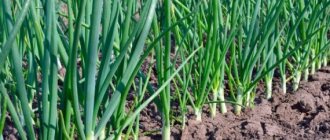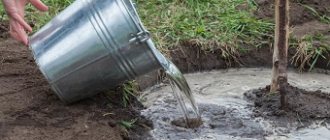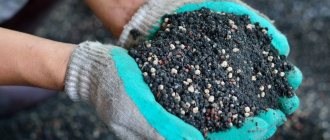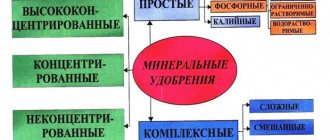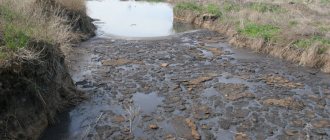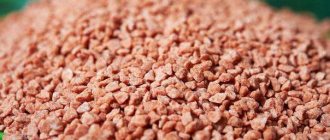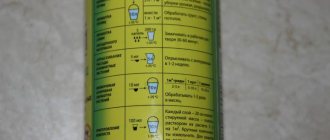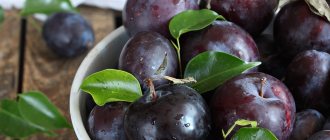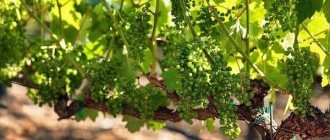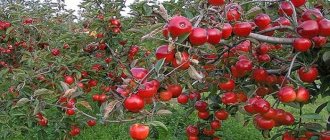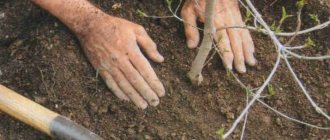Fruits and berries » Plum
0
311
Article rating
Kira Stoletova
A balanced and regular diet plays an important role in a plum garden. It is especially important to apply it correctly and on time before the onset of cold weather. Let's consider how to feed a plum tree in the fall, and when is the best time to do it?
Preparations and timing of feeding plums in autumn
Wood ash
The ash resulting from the combustion of deciduous trees is a useful and valuable fertilizer. It contains about 17 minerals necessary for the full growth and development of the tree and its abundant fruiting.
In addition to replenishing mineral reserves in the soil, ash reduces its acidity. This also has a beneficial effect on the development of plums, since they prefer neutral or slightly alkaline soils.
To fertilize an adult tree, 250 g of ash is required. It is diluted in a bucket of water and infused for 24 hours. Then the infusion is mixed well and poured into the hole under the plum.
Sheltering a plum tree in the fall for the winter
When preparing the plum for the upcoming winter, it is necessary to whiten the tree trunk (in young trees and skeletal branches). Whitewashing is designed to protect against severe frosts. Conventional insulating material, namely plastic film and burlap, will also help preserve young trees. So, the base of the fruit tree should be carefully wrapped in burlap, and several layers of plastic film should be placed on top of it. Insulating tape must be glued to the film in order to limit the possibility of moisture getting under the insulating material. It is recommended to cover the bottom of the trunk with manure.
Bone flour
Bone meal saturates the soil with phosphorus, calcium and nitrogen. These substances are necessary to activate the growth and strengthen the root system of the tree, lay flower buds, and enhance fruiting.
Bone meal (2 cups) is added to the trunk circle of an adult plum tree and the soil is loosened well. Such feeding is usually carried out once a year in October–November.
Timing of work
You can feed a plum with different components, but the timing of the work differs depending on the region and the age of the tree.
- In the first three years after planting, seedlings that are planted in fertile soil do not need nutrition.
- In the fourth year of life, beneficial agents are applied at the end of summer, a month before the onset of persistent autumn cold, so that the root system has time to absorb all the necessary substances. Due to this, the frost resistance and winter hardiness of plums will increase.
The dates for applying fertilizers in October are as follows:
- in the southern zone and central zone - the second half of the month;
- northern regions - first decade.
Foliar nutrition of the crown with a solution of copper, iron sulfate or Bordeaux mixture is carried out immediately after harvesting the fruits, and preferably before the leaves fall. The best time for this is evening hours. It is important that the day is dry and warm.
Compost
The addition of well-rotted compost and manure improves the soil structure and saturates it with organic matter. In the fall, a bucket of this fertilizer is added to the tree trunk circle, after which the soil should be loosened well.
If the plum grows on acidic soils, then compost or manure should be mixed with 500 g of lime. This will not only prevent further acidification of the soil, but will also have a slight alkalizing effect.
Caring for an adult tree
Just at this time it enters the time of fruiting. That is why fertilizing in spring and autumn becomes very important. Plum is very responsive to such procedures. Every year you will now need to perform the following manipulations:
- The soil around the trunk needs to be dug up to a depth of 20-30 cm.
- In the spring, you definitely need to add organic matter. It could be an infusion of manure. One m2 will require 10-15 kg of organic fertilizer. Rotted manure can be combined with peat and urea, superphosphate and wood ash.
- In summer, there begins a period of active growth of the plant itself, as well as the formation of fruits. At this time, it is especially important to pay attention to the introduction of nitrogen and limestone, which helps normalize the acidity of the soil.
- With the onset of September, the tree is dormant. Now it becomes relevant to fertilize from wood ash and sand, which is applied to the soil previously dug around the trunk.
These measures allow not only to ensure regular tree care, but also to prevent the occurrence of phytodiseases and damage by rodents. In the future, this will ensure a large harvest of large plums next season.
Urea
Cold and rainy autumn weather creates favorable conditions for the emergence of various diseases of plum trees and their damage by various pests.
Foliar fertilizing with urea helps prevent such negative phenomena.
Treatment with a urea solution reliably protects trees from the following problems:
- fungal infections;
- infestation with parasitic larvae;
- putrefactive processes;
- spotting;
- scab.
Treatment should be carried out only after the leaves have completely fallen. Otherwise, the urea solution may cause leaf burns and premature leaf fall. This will cause the tree to weaken and die in winter.
Treatment with urea is carried out in calm and dry weather at an air temperature of at least +5° C.
For 10 liters of water take 500 g of urea. The solution is thoroughly mixed and then filtered several times through a cotton rag. The liquid is poured into a garden sprayer and the tree trunks and branches are thoroughly treated.
To saturate the soil with nitrogen and improve fruiting during pre-winter loosening, it is recommended to add urea to the soil at the rate of 25 g per square meter of tree trunk space.
The importance of fertilizing
By applying fertilizers, the gardener:
- improves soil composition;
- introduces macro and microelements necessary for plant growth in the required quantities;
- increases productivity;
- increases the sweetness and juiciness of grown products;
- increases plant resistance to diseases;
- fights pests.
By feeding the plum in the spring, before flowering, the gardener stimulates the plant to grow new shoots and flowers, which entails an increase in yield.
Fertilizing in the summer during fruiting supports the plum, helping it bring the harvest to ripeness and not shed unripe fruits.
With autumn fertilizing, the gardener compensates for the spent supply of phosphorus and potassium for harvesting. The tree should go into winter not depleted, but with a supply of nutrients for successful spring flowering. If this is not done, the plum will not have time to form flower buds in the fall and will take a rest next year.
Therefore, to obtain stable yields and preserve a healthy tree for many years, it is impossible to do without applying certain doses of mineral and organic fertilizers.
Attention! Some people mistakenly call a plum a berry, but it is a fruit.
How plum trees let you know what kind of feeding they need
Trees react to a lack of macro and microelements in the soil by dropping unripe fruits or ovaries, changing the size and color of leaves.
All this can be seen in this table:
| Chemical element | Symptoms of lack of macro and microelements |
| Nitrogen (N) | Shredding of leaves with loss of color is observed The ovaries and fruits fall off Weak growth of young shoots Redness of the bark |
| Phosphorus (P) | The period of flowering and harvest ripening is extended Poor shoot and root growth The appearance of leaves with red and purple hues Early leaf fall |
| Potassium (K) | Leaf curl appears Leaf color becomes faded |
| Magnesium (Mg) | Dropping of unripe fruits Change in leaf color to whitish with further death |
| Copper (Cu) | Chlorosis appears on the leaves The tops of the shoots die off Side buds awaken |
| Iron (Fe) | Leaf color disappears Early leaf fall Fruit crushing The tops of the shoots die off |
| Calcium (Ca) | Bones form slowly The tips of the shoots die off Plum growth slows down Ovary and foliage fall off |
| Zinc (Zn) | The leaves are getting smaller The fruit pulp turns brown Young shoots are thinning |
Upon careful examination of the fruit tree, the gardener understands what elements are missing for successful fruiting.
Feeding methods
Fertilizers are divided both according to the method of application and the form of the applied fertilizer.
There are two ways to feed:
- Root, when the fertilizer reaches the roots of the tree.
- Foliar, in cases of spraying a nutrient solution on leaves and branches.
Foliar applications are used at the beginning of the season, when there is a need for rapid delivery of nutrients to their destination (2 days).
Root feeding is applied:
- in the form of a solution, maintaining a certain concentration;
- in the form of granules or powder, scattered under the plants, mixing a little with the ground.
Fertilizers in the form of granules are used when feeding in the spring before the leaves bloom or in the fall. For these purposes, poorly soluble superphosphate and azophosphate are suitable, which, gradually dissolving, will supply the plant with nutrition throughout the entire growing season. And the preparations introduced in August and September (potassium monophosphate, potassium magnesium) will replenish the macro and microelements consumed in the summer.
Mortar
With prolonged use of the soil, its pH level decreases. This leads to gradual acidification of the soil. The first sign of a problem is the rapid overgrowth of lumps of earth with green moss.
Plum does not like acidic soil and therefore needs to be fertilized with lime every 5 years. This procedure should be carried out in late autumn, as it is most effective at this time.
Lime application rates per square meter depend on the nature of the soil:
- light sandy – 250-500 g;
- alumina or loam – 350-600 g;
- clay – 450-800 g.
To more accurately calculate the required amount of lime, it is better to focus on the pH of the soil, which can be determined using special test strips or by submitting a soil sample to the laboratory.
The required amount of lime is diluted in a bucket of water, mixed thoroughly and the solution is poured into the tree trunk space. After this, the soil is thoroughly loosened.
Pruning plum trees in autumn
Caring for young plum trees in the fall involves pruning. After planting the tree, the central shoot is cut off by a third. Thanks to this technique, the crown will develop correctly in the future, the branches will be parallel to the ground, and not stretch upward.
For medium and old trees, you need to regularly trim branches that thicken the crown or intersect with other damaged branches. Try to leave branches parallel to the ground and remove young twigs that grow vertically. It has been noticed that parallel branches give greater yield and are better illuminated by the sun.
Whitewashing plums in autumn
The bark of trees is rarely perfect (especially in mature crops): it cracks, flakes, dies, and mosses and lichens appear on it. Therefore, before whitewashing, tree trunks must be brought into proper shape. The easiest way to obtain a whitening composition is to purchase it in a store. On sale you can find mixtures based on lime and clay. Their main advantage is that they do not “clog” the trunk and allow the tree to “breathe” freely.
However, these products also have a drawback: by spring they are washed off the bark, and the trees need to be whitened again. Although responsible gardeners already re-whitewash in the spring, this should not be a big problem.
Methods of protection against rodents
In frosty, snowy winters, the bark of young seedlings is a real treat for rodents. During this period, visits from hares and mice and voles become frequent. Protecting plum trunks and shoots from wild animals involves covering and using deterrents.
To prevent rodents from damaging the bark, plum trunks are wrapped for the winter with one of the following materials:
- roofing felt;
- spunbond;
- fiberglass;
- elastic tape;
- burlap;
- nylon tights;
- spruce spruce branches;
- metal mesh.
For effective protection, rodent repellents are additionally used. You can prepare fragrant mixtures yourself or purchase them at garden retail outlets.
| Rodent protection products | ||
| Tree protection method | Characteristics of the method | Species of rodents |
| Repelling animals | Tying dark colored plastic bags to the branches of a fruit tree | hares |
| Mechanical barrel protection | Installation of a metal mesh fence along the diameter of the tree trunk circle. Digging into the ground around the trunk pieces of old pipes, buckets without a bottom, cut along the long side. Tying the root part of the trunk with roofing felt, burlap or iron mesh, similar to chain mail. Attaching the legs of spruce crops with the needles down to the trunk with a rope | hares, mice |
| Treating the trunk with an odorous mixture | Coating the trunk with a similar mass of equal proportions of clay and fresh cow dung with creolin (50g/10l of water) | hares |
| Fence installation | Construction of a fence around a plum tree using scrap materials with wide slits | hares |
| Using repellent mixtures | Place sawdust near the tree trunks, soaked in a solution of 5 g of creolin or carbolic acid in 1 liter of water | mice |
| Use of aromatic plants | Laying bunches of coriander sprigs, peppermint or cilantro under the plum | mice |
ATTENTION! Ruberoid is used with caution, since this material does not allow air to pass through and quickly heats up in the sun, which leads to the trunk rotting and peeling of the bark.
Basic mistakes
The main mistakes when carrying out work are:
- Failure to comply with standards when applying fertilizers. Some gardeners determine the amount of nutrients “by eye”, as a result of which the tree receives insufficient or excessive amounts of one or another microelement. This negatively affects the growth, fruiting and winter hardiness of the plant. To avoid this problem, before fertilizing, you need to familiarize yourself with the fertilizer application rates and use a measuring cup.
- Failure to comply with feeding deadlines. If fertilizers are applied too late, they do not have time to be absorbed, which leads to a decrease in the frost resistance of the tree.
- Apply fertilizers only at the roots. In this case, the branches may receive an insufficient amount of nutrients, as a result of which their growth will slow down and new fruit buds will not form.
Fertilizer application stages
There are three stages of plum feeding:
- Before flowering . The soil is thoroughly loosened, watered and urea and potassium sulfate are added.
- During fruit filling . Urea and nitrophoska are used.
- At the end of fruiting . Superphosphate and potassium sulfate are used.
